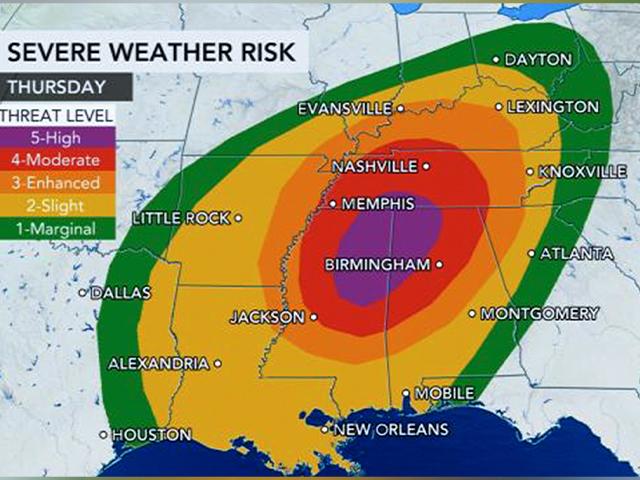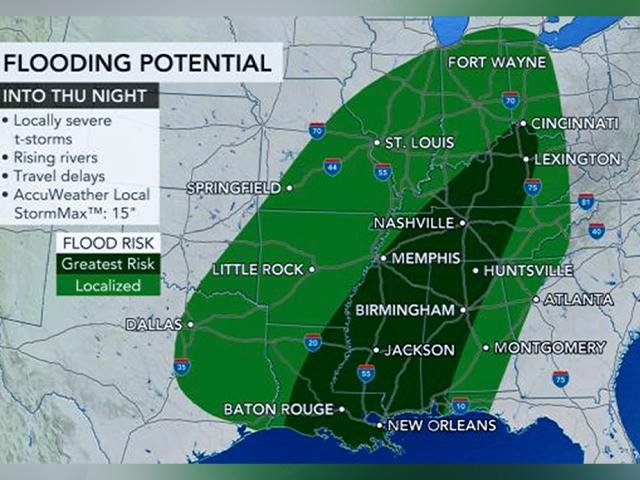
Tornado Threat: Severe Weather Danger Triggers Second 'High-Risk' Threat in a Week
The National Weather Service's Storm Prediction Center has issued a rare category 5 out of 5, "high risk" for severe weather, including potentially "violent" tornadoes, for northern Alabama, central and northern Mississippi, and western and middle Tennessee.
AccuWeather meteorologists continued to warn on Thursday that a life-threatening severe weather outbreak looms across a large part of the southern United States stretching from the Gulf Coast to the Ohio Valley, with the potential for dangers to linger into the nighttime hours. At least 50 million Americans are in the path of severe weather, including storm-weary residents of the Mississippi Valley still recovering from destructive tornadoes just over a week ago.
AccuWeather Chief On-Air Meteorologist Bernie Rayno pointed out that words like "possible" or "likely" are not on the forecast maps for Thursday and Thursday night. “These are definite," he warned. "There’s going to be a tornado outbreak. There’s going to be widespread wind damage, and there’s going to be hail,” he added.
The storm set to trigger the severe outbreak shifted east out of the southern Rockies, where heavy snow was falling on Wednesday before producing thunderstorms and large hail across the southern Plains into Wednesday night.
Some hail reports across Texas were as big as pool balls and baseballs.
Even though there is still the potential for cloud cover and wet soil conditions to limit the intensity of some of the storms over the lower Mississippi and Tennessee valleys on Thursday, that safety net may not be enough to prevent a significant amount of violent thunderstorms.
Gulf of Mexico waters have warmed significantly in the past few weeks, and the strengthening sun this time of the year may be enough to burn through the clouds and help warm the lower part of the atmosphere. Water temperatures along the upper part of the Gulf of Mexico were in the 60s to lower 70s F as of midweek.
It is the warm, moist air near the ground that helps to fuel thunderstorms, and when strong winds are present aloft, particularly when winds increase in speed and change direction at higher levels of the atmosphere, thunderstorms can become intense, rotate and produce tornadoes.
These conditions are expected to be present in the setup Thursday to Thursday night, especially across the northern parts of Mississippi and Alabama into eastern Arkansas, the northeastern corner of Louisiana and western and central Tennessee.
For the second time in a week, the National Weather Service's Storm Prediction Center (SPC) has issued a high risk of severe weather. This corresponds to a level 5 on the National Weather Service's severe weather alert scale. The lowest level or 1 corresponds to a marginal risk, while a level 5 represents a high risk.

(Image credit: Accuweather)
The last time that SPC issued two high risks for severe weather in the month of March was 30 years ago in 1991.
This is the second of two storms to threaten severe weather in just one week. Portions of the lower Mississippi and Tennessee valleys were hit with destructive severe weather and tornadoes. During St. Patrick's Day, March 17, alone, 56 reports of tornadoes, 27 incidents of large hail and 79 episodes of damaging wind gusts were tallied by the SPC.
Alabama was dealt some of the most destructive severe weather last week. An EF2 tornado touched down in Chilton County on Wednesday, spawning 130-mph winds. An EF1 tornado packing 110-mph winds struck Moundville, Alabama, causing severe damage to buildings and ripping roofs off homes.
AccuWeather meteorologists believe that some risk of severe thunderstorms and perhaps an isolated tornado exists as far north as the Ohio Valley, but the greatest threat of tornadoes will be farther south from Tennessee to near Interstate 20 in Mississippi and Alabama. Storms that cruise through the Ohio Valley are expected to unleash the threat of damaging wind gusts.
Severe weather will be underway during the early to middle part of the afternoon as discrete thunderstorm cells are expected to erupt across areas like Mississippi, Alabama and northward into Tennessee, according to Rayno. Thunderstorms that ignite in this manner, rather than as part of a more organized line can be particularly dangerous and are most likely to spawn tornadoes.
CLICK HERE FOR THE FREE ACCUWEATHER APP
There is still some risk of storms capable of producing tornadoes after dark, but this should be more of an exception now thanks to the shift of daylight hours associated with daylight saving time now in effect. Late-night tornadoes appear to be unlikely at this point, but AccuWeather meteorologists will continue to closely monitor the situation.
Nighttime tornadoes, especially those that occur late at night, are especially dangerous as many people may not know a storm is heading to their neighborhood unless closely monitoring severe weather watches and warnings.
The AccuWeather app is a valuable tool in keeping up-to-date with severe weather with up-to-the-second warnings.
Any thunderstorm in the alert zone can easily produce wind gusts between 40 and 60 mph with an AccuWeather LocalStorm Max™ of 80 mph. At this force, there is the risk of property damage, falling trees and sporadic power outages.
In addition to the likelihood of violent thunderstorms, there remains a significant risk of flooding over the same general area of the nation.
As the first storm system encountered Gulf of Mexico moisture into Tuesday night, gusty and locally drenching thunderstorms led to incidents of flash and urban flooding along the northern part of the Gulf coast.
National Weather Service hydrological data indicated that the Contraband Bayou near Lake Charles, Louisiana, rose rapidly to major flood stage on Tuesday morning in response to heavy rainfall. Flood stage for the site is 8 feet, but the level had reached 12 feet at the start of the day on Tuesday. Major flooding begins at 10 feet. More incidents such as this are anticipated in the coming days from the Mississippi River Delta region through the Tennessee Valley.
From noon Tuesday to 8 a.m. Wednesday, more than 6 inches of rain fell on New Orleans and triggered incidents of urban flooding in the city.
"In the Interstate 10, 20 and 40 corridors in the Mississippi Delta and lower Mississippi Valley region, a general 4-8 inches of rain is anticipated during the middle days of this week, with the bulk of that rain expected to fall from Wednesday to Thursday," AccuWeather Senior Meteorologist Brett Anderson said. Where the heaviest rain pours down and repeats, an AccuWeather Local StormMax™ of 15 inches is anticipated.

(Image credit: Accuweather)
"Some of the rain from Tuesday to early Wednesday fell on areas that were hit with flooding downpours during last week's severe thunderstorms," Rayno said earlier in the week.
Rainfall from last week alone was anywhere from two to five times that of average. The bulk of the rain last week fell in two days -- on March 16 and 17.
For example, Meridian, Mississippi, received 4.42 inches of rain on March 16 and 17, compared to a normal of 1.21 inches of rain for the third week of the month. Meridian is within the zone of anticipated heaviest rainfall at midweek.
Birmingham and Huntsville, Alabama, are forecast to be within the zone of the potentially excessive rainfall this week, and both locations received about 4.5 inches of rain on March 16 and 17.
Other cities that have the potential to experience problems from excessive rainfall this week include Memphis and Nashville, Tennessee; Little Rock, Arkansas; Jackson and Tupelo, Mississippi; and New Orleans and Baton Rouge, Louisiana.
This reoccurring rainfall has the effect of keeping the ground wet. The fact that flooding may not have occurred in some communities yet does not mean these same areas are immune to flooding into Thursday night.
The latest surge of wet weather into Thursday night is forecast to be intense and persistent enough to raise the risk of small stream flooding and rises on the rivers, in addition to the likelihood of urban flooding.
***As the number of voices facing big-tech censorship continues to grow, please sign up for Faithwire’s daily newsletter and download the CBN News app, developed by our parent company, to stay up-to-date with the latest news from a distinctly Christian perspective.***




